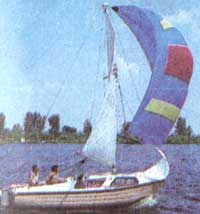
Sailing history... of mine
Cruising exprerience
I plan to tell a bit about how and when I start dreaming about sailing and my little cruising experience.
It started at school, in grade seven, I think. From kindergarden to grade two, I had played the piano, which I resumed later in grade 9 and even graduated a musical school (jazz branch) when I was first year student at the Navigation Faculty of the Institute of Water Transport Engineers. Grades three to six I played soccer. In grade seven, we had had an option to study sailing. I had to say that this was in Novosibirsk, Siberia, Russia. The only decent place to sail there was so called Ob' sea, basically a large water reservoir developed in a result of a dam that was part of a hydro power plant.
The classes had started in winter when everything was frozen, of course. There were therefore, only theoretical classes filled with basics of sailing, sailboat and sail types, vocabulary, flags, racing rules, Morse code, etc. At the end, from the original thirty students only five remained and passed the exams. Other people got bored and quit.
The following summer brought some fun. It was a canoe trip on Dnepr river in European part of Russia and Belorus republic. Our teacher, Georgi Dobrov, was WW2 veteran and decided to pay a tribute to the glory of the Soviet army defeated Nazi Germany.
Besides canoeing, there were many land trips to historical fight sites and meetings with local authorities and schools where our trainer told WW2 stories when he had been flying UN-2 fighter as a shooter.
It wasn't an ordinary rowing canoe, by the way. It was the sailing twin hull canoe but to keep it on a course, we had to row and row a lot.
Three men in a boat to say nothing of the dog
Another winter brought more sailing classes including advanced and celestial navigation. We had been preparing for the next summer voyage to St. Petersbourg on 16-foot sailboat Assol.

We had began in April departing from Novosibirsk and sailing downsteam Ob river. I had still been at school and had to join the captain and another crew member, not counting the dog, later in Surgut, a town located downstream of Ob river famous for its oil rigs.
We were in a bit of rush trying to reach Salehard located at the beginning of Ob Bay of Karskoe sea in the Arctic ocean, by early summer to catch a few days when you could actually squeeze through an narrow passage between ice and a shore without following the ice-breaker. Therefore, sometimes we sailed for 24 hours taking 4-hour shifts. One person navigated the boat while others rested.
I remember the first serious feeling of being responsible for the lives and safety of your sleeping crew members when it was my turn to take the steering wheel. There was an exciting moment when all my theoretical knoweldge obtained during winter classes came together and help navigating the boat alone, even at night.
We were far north, and polar summer nights were not dark. The closer we were to the arctic circle, the more difficult it was to tell the difference between a day and a night. When we finally reached the arctic circle in Salehard, it became almost impossible.
The Arctic didn't clear that summer. In about four weeks we gave up the hope to conquer the Arctic ourselves. We sailed to New Port in Ob Bay where we were picked up by a cargo ship and delivered to Arhangelsk in the White Sea. I needed to say that the cargo ship had followed an atomic ice-breaker almost all the time on its way through Kara and Barents seas in the Arctic ocean.
We had spent an unforgetable week exploring the preserved Solovetskie islands and then sailed down the Belomoro-Baltic Channel via Onejskoe and Ladojskoe lakes to St. Petersbourg. It had been known as Leningrad at that time.
Next year, the Arctic had been kind and let our 16-foot sailboat make its way back through ice but with a different crew!
First steps
After the exciting trip to St. Petersbourg, I got inspired by sailing and this was likely the time when I had begun dreaming of my own boat. I spent summers in a country with my gandma. The village was on the Ob' sea south of Novosibisrk. We used to gather mushrooms in the forest, dry them up and sell in a winter on a market. The white mushrooms were very valuable at that time and I was able to earn money for an inflatable dingy.
I used it mostly for fishing but soon got an idea to put a sail on it. This became my first hand-made sailboat! I had to reinforce the bottom with a plywood, make two keel boards on both sides, a wooden mast and even sewed a sail! I used an oar as a rudder. And it did sail! Quite well, by the way.
Georgia Straight in British Columbia, Canada

The rest of my sailing experience was all in Georgia Straight around Vancouver and Vancouver Island. I was a member of Cooper Boating Centre located on Granville Island in Vancouver and chartered boats from 21 to 34 feet long, mostly for a weekend.

